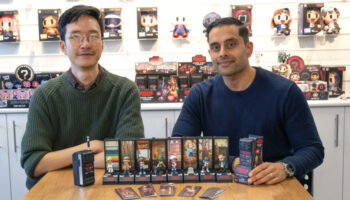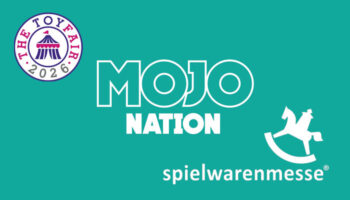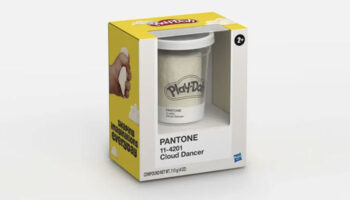Moose Toys’ James Austin-Smith on the top-secret, mould-breaking design process behind Magic Mixies

Last month saw Moose Toys debut Magic Mixies, a new toy that allows children to conjure up a magical potion and create their own magical pet.
The Magic Mixies Cauldron comes with all the magical ingredients needed to make a furry friend. Children find the spell from the Spell Book, then add magical ingredients such as a Glitter Star, Crystal Gem, and Magic Feather to the potion to help bring their creature to life.
Once the potion is mixed, children pop the name of their creature into the cauldron and then a magical mist appears from the cauldron before their Magic Mixie is revealed.
We spoke with James Austin-Smith, Innovation Director at Moose Toys, to find out more about the design wizardry behind Moose’s latest magical innovation.

James, always lovely to catch up. Let’s dive straight into Magic Mixies. What inspired the idea?
It was a little bit of a lot of things!
Magic has been a popular trend since Harry Potter. Before then, the focus was largely on stage magic and magic tricks, which was separate from the world of wizards. Magicians did tricks, whereas wizards did a mythical thing that no-one has access to, but Harry Potter put magic in kids’ imaginations. Magic became aspirational.
That said, the idea for Magic Mixies first came up back when we were working on Scruff-a-Luvs. We were looking at where we could go with it in the future, and with plush, we always try and look for ways to form an emotional connection between the child and their toy. A creation story is about as pure a version of that as is possible, but childbirth itself doesn’t always translate brilliantly into a play experience in a toy! It’s a hard one to manifest!
We were looking at different ways to tackle creation, and considered magic and how you might magically create a toy. If I was a child and I was going to magically create something, how would I do it? We brainstormed around that, and then married it up with a behaviour that anyone who has spent time with young children will have seen: kids creating magic potions.
When I say creating potions, I mean kids grabbing plants and mud and mum’s expensive shampoo, dumping it in a bowl of water and stirring it for a few hours. We hypothesised around this being quite a prevalent play pattern because we’d all seen it in our own families. On further investigation this seems to be an international play pattern. So far, I’ve not bumped into anyone that doesn’t recognise the behaviour.
Absolutely, I’m certain I would’ve done that as a kid.
Yes! Lots of people remember doing it themselves! So it was interesting that there’s an organic behaviour that children do, and no-one had created a toy around it. We wanted a really engaging creation process, so we thought it would be cool for kids to create a magic potion, and that potion actually turns into their plush toy.
That was the starting point. There were also plenty of other random ideas floating around… Ross had been doing some work on an axolotl that you could tie-dye and that led us to look at the relationship between ingredients and your Magic Mixie’s appearance. I’d been playing with an idea for a fantastical creature plush that had a gem in its head and responded to a magic wand; that made its way in too!
Amazing. Now I should add a video in here of Magic Mixies in action because it really is a special thing to watch…
Now, you can’t see how this potion is actually transforming into a toy thanks to some impressively thick mist; why go to that extreme to mask that moment?
If you watch a good magic trick performed by a good magician, it doesn’t matter how old you are, you get excited and can’t help but wonder ‘How did they do it?’ It’s that mixture of surprise and delight that creates memorable experiences. We wanted kids to experience that with Mixies and for it to fuel kids’ imaginations.
The now patented tech inside is a brand new invention, but kids don’t care about that. Kids care about getting lost in the moment. We didn’t want anything to break their suspension of disbelief by letting them see how it works. We wanted to keep kids locked in that experience, so straight out of the box, kids just have to add water and they’re away.
We hope that when kids open it on Christmas day, it’ll create some magical memories that’ll last well into adulthood.

I imagine kids and adults alike will be scratching their heads as to how it works, so how tricky was the development process behind Magic Mixies? How tough a nut to crack was this one?
We did the initial legwork here in the UK, and then we handed it over to our brothers and sisters in the youth electronics team in Melbourne who look after Little Live. Their engineering skills are amazing so were perfectly placed to bring the idea to reality!
Embracing your nut analogy, we had plenty of tough nuts to crack at the beginning – and then we handed over our cracked nuts to Melbourne, along with a whole new bunch of nuts for those guys to crack! It was a difficult project right the way through, and that’s before factoring in Covid and all the other challenges anyone faces developing product right now.
In terms of some of the difficult things, we didn’t have mist in the beginning. To start with, we had a creature that rose up out of the potion like the Lady of the Lake, but we were tasked with keeping the toy dry after we showed the initial concepts. That also made it more magic, for the potion to disappear and a dry creature to appear.
So the first challenge was: How do you have wet potion go into the cauldron and a dry plush come out – and for the potion to have totally disappeared!
Challenge number two was: How do you conceal the moment where the potion becomes the plush? That’s where we came up with the mist Someone half joked that it would be cool for it to be a steaming potion, and someone else mentioned atomisers that vaporise water. That’s not actually how this works; water vapour isn’t opaque enough so we had to devise something else.
We wanted a mist so thick that you couldn’t see the switching process. We toyed with the idea of the cauldron having a lid that you put on to hide the switch, but it felt like cheating!
The final challenge was: If we can make all this work, how the hell do we make it affordable!?
So quite a few mountains to climb there. Talk us through that transformation from potion to toy.
Well, we’re not engineers here in the UK; we’re designers, tinkerers and toy enthusiasts that have somehow become professionals! We built a bunch of different cauldrons and mechanisms – some worked brilliantly, and many didn’t, but we eventually came up with the final mechanism. I won’t go into too much detail – because it’s magic! – but there’s a spring inside that does a lot of the work and some very refined Australian engineering holding it all together.

And there was no outside help on the project, in terms of inventors or design studios?
We did a concept presentation to Melbourne HQ, before we made the models, and they said, “It’s great, but is it even possible?” We said yes, and they said “Prove it!”
We only had a few weeks to make something tangible to back up our concept presentation and show it was feasible. And, whilst we would regularly work with inventors on something like this, our solution and innovation was achieved quite early on for this launch item… it just needed proving out, so it ended up staying internal. Of course if we hadn’t had a solve at that point we would have reached out to the community.
I imagine with something this innovative, there’s a big push to keep it all hush-hush for as long as possible?
Absolutely. We have a lovely industry, but there are times where companies come out with similar stuff at similar times. There was a real fear that if another company got a whiff of what we were doing and decided to do something in the same space, our launch would lose its impact.
It was agreed that this would be heavily embargoed, internally as well as externally. We were developing it in the UK at the time, so most of the company hadn’t seen it and it was easy to keep it quiet. Outside of the design office, most of the company in the UK work in sales and marketing, so it was simple to keep it away from them as well. It was the most secretive project I have ever worked on.
So how many people knew about it during development?
In the UK, there were seven people involved in the project. In Melbourne, not counting senior management who were in that initial presentation, there were a couple of engineers, a lead designer – Dean and a Design Director – Rowen plus a few people in the Little Live team. That was it!
And this was all going on during the pandemic too?
Yes, when the pandemic hit, we were in a place where all of a sudden we couldn’t get models made in the UK. We could’ve gone to Hong Kong model makers who were back up and running, but we didn’t want to show external companies the product. We ended up getting individual parts made by different firms in different countries. They would all be posted in and we’d fettle stuff to make it all fit together.
Some did the plush, some did the electronics. It was the only way we could get things made without people knowing what we were doing. So Sound did sounds for the project before we could show them the concept! It was challenging, but in retrospect it was quite cool.
Wow! Sounds like an exciting process to be a part of.
It was exciting. It was an ongoing mix of excitement and everything feeling like it was harder than it should be – and it was already very difficult!

You mentioned earlier that you could have saved yourself a lot of headaches had you opted to put a lid on the cauldron – but that felt like cheating. I’m sure there are other companies that would’ve gone down the lid route, so what does it say about Moose that you didn’t take that option and were instead focused on getting the fog right?
Everyone I’ve met at Moose genuinely loves what they do. We are passionate toy people. We’re not designers that have just ended up doing toys, even if many of us started in other industries. There’s a real excitement about toys, play and doing something meaningful.
It’s not our official corporate manifesto, but there’s a genuine push from the people that own the business that they want to make the best toys. They want the company to be known for making the best, most innovative, most interesting toys – and that culture permeates throughout the business.
Back when we were Worlds Apart, that was also our ethos and I think that’s why we’ve been so compatible following the acquisition. We are driven by making great toys and great experiences for kids.
Looking ahead, is this just the start for the Magic Mixies brand?
It’s an exciting brand to work on because the possibilities are pretty broad. There’s only so much I can say here, but if the market responds to it in the way that we hope it does, we’d like it to be a brand that people associate a lot more with than just the cauldron. It’s going to be an interesting, diverse brand that has magic running through it.
Is it a brand that inventors can pitch concepts for moving forward?
Absolutely! Now Magic Mixies is out there, the gates are open and we’re expecting to see lots of great ideas coming in. The gauntlet to lay down is that inventions in this brand have to be really magic!
Has the process of designing Magic Mixies changed how you’ll design moving forward?
I think the whole team here is fundamentally changed on some levels, because we didn’t know if we could pull this off, and we could. Both Magic Mixies and Scruff-a-Luvs started with an impossible dream, and now I’d say our creative ambition is deeper than ever. We’re braver than we were and we’ve raised our own bar. There will be more ideas from us in that vein of pushing innovation – so watch this space!
James, this has been great. Congrats to you and the team on Magic Mixies; I look forward to seeing what’s next for the brand moving forward. And I’ll leave people with this step-by-step video so they can check the entire Magic Mixies process. Thanks again!

























